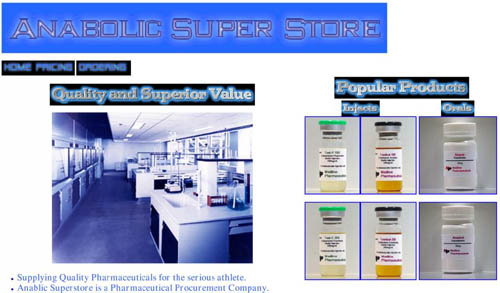A severe cocaine addiction helped a convicted steroid dealer obtain a more lenient sentence against the objections of Acting United States Attorney Nora Dannehy according to court documents. United States District Judge Mark R. Kravitz shortened the prison sentence of Edwin Porter (operator of Medline Pharmaceuticals sold via Anabolic-Superstore.com) since his “severe addiction to cocaine undoubtedly contributed to Defendant’s poor judgment” of conspiring to distribute anabolic steroids.
Edwin Porter completed a six month inpatient drug treatment program at Recovery House Inc. as a condition of his bond followed by another six months of weekly outpatient substance abuse counseling at Southwest Behavioral Clinic. Consequently, Judge Kravitz granted Porter a downward departure of six months from the Government’s sentencing recommendations of 30-37 months such that Porter was sentenced to 22 months imprisonment at facility that offers a Residential Drug and Alcohol Abuse Program.
The following sentence is imposed pursuant to the Sentencing Reform Act of 1984. The Court imposed a non-Guidelines sentence… However, Mr. Porter had spent six months in an inpatient drug rehabilitation program following his arrest, and the Court felt that he should get credit for the time spent, in effect, in custody in that program. Also, Defendant had no prior criminal history points and therefore he had not been in prison previously. For these reasons, the Court believes that a sentence of 30 months, which the Government advocated, was not appropriate. Nonetheless, the Court rejected Defendant’s request for a non-custodial sentence for several reasons. First, the nature of the offense was quite brazen and substantial. Second, Defendant was well aware that what he was doing was illegal, though a severe addiction to cocaine undoubtedly contributed to Defendant’s poor judgment.
Defense attorney Bruce Koffsky used the argument for “extraordinary rehabilitation” as grounds for departure from sentencing guidelines of 30-37 months advocated by the government. While Koffsky failed to obtain the desired sentence of 6 months addition inpatient treatment at Recovery Homes and 6 months home confinement, he successfully obtained a “non-guideline” reduced sentence from Judge Kravitz based on his client’s rehabilitation from a decades-long addiction to steroids and cocaine. (Actually, the “addiction” to anabolic steroids last for decades while Porter experimented with cocaine as a teenager and resumed the year prior to launching Medline Pharmaceuticals.)
The defense strategy is noteworthy, not only because of its limited success, but because extensive steroid use often precedes an individual’s involvement in steroid distribution. The “extraordinary rehabilitation” from an “addiction” to steroids, while completing ignoring any distinction between use and abuse, could favorably affect sentencing. Of course, the judge seemed particularly influence by the severe cocaine addiction moreso than the steroids.
It is well established in the Second Circuit that extraordinary rehabilitation can be a basis for departure. The courts have consistently recognized that the awareness of one’s circumstances and the demonstrated willingness to act to achieve rehabilitation, thereby benefiting the individual and society, can remove a case from the heartland of typical cases, thus constituting a valid bases for departure. United States v. Core, 125 F.3d 74, 76 (2d cir. 1997)(internal citations omitted). See also United States v. Davis, 763 F.Supp. 645, 652 (D.D.C. 1991)(downward departure where drug addiction primary cars of criminal behavior and high likelihood of successful treatment); United States v. Rodriguez, 741 F.Supp. 12, 14 (D.D.C. 1990)(downward departure where defendant using drugs since early age and subject to childhood abuse). The rationale behind such departures is that rehabilitation is a valuable achievement of the criminal process. United States v. Core, 125 F.3d at 77.
By the time the defendant was arrested for the instant offense, he was addicted to both anabolic steroids and cocaine and in need of intensive treatment. The defendant was introduced to drugs at an early age and certainly by the time of his arrest, substance abuse had been part of his daily routine for decades. The defendant had never before participated in drug treatment and it has taken internal fortitude and commitment to struggle past the pangs of addiction.
Koffsky noted that District Judges are free to ignore sentencing guidelines and government recommendations if he or she feels it is inappropriate.
The Guidelines provide the starting point and the initial benchmark for sentencing, Gall, 128 S. Ct at 596, and the District Courts must remain cognizant of them throughout the sentencing process, id, at 596 n.6. It is now, however, emphatically clear that the Guidelines are guidelines “ that is, they are truly advisory. United States v. Cavera, Docket No. 05-4591-cr (2d Cir. December 4, 2008) [Emphasis added]. A district court may not presume that a Guideline sentence is reasonable, it must instead conduct its own independent review of the sentencing factors, aided by the arguments of the prosecution and defense. District Judges are, as a result, generally free to impose sentences outside the recommended range. Id. The Second Circuit does not presume that a Guideline sentence is reasonable nor that a non-Guideline sentence is unreasonable.
The court documents provide interest insight into sentencing decisions in anabolic steroid cases.
�
About the author
Millard writes about anabolic steroids and performance enhancing drugs and their use and impact in sport and society. He discusses the medical and non-medical uses of anabolic-androgenic steroids while advocating a harm reduction approach to steroid education.


No replies yet
Loading new replies...
Join the full discussion at the MESO-Rx →